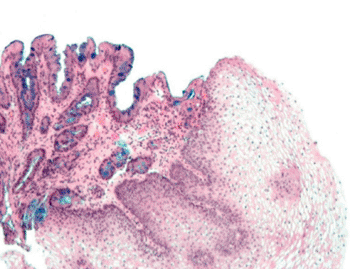Genome-Wide Association Study Identifies New Susceptibility Loci for Esophageal Adenocarcinoma and Barrett's Esophagus
By LabMedica International staff writers
Posted on 21 Oct 2013
Results obtained during a large genome-wide association study yielded three previously unknown gene associations linked to the risk of esophageal cancer and its precursor, Barrett's esophagus. Posted on 21 Oct 2013
Esophageal cancer (more than 60% being esophageal adenocarcinoma) affects nearly 18,000 Americans annually with more than 15,000 fatalities. A precursor syndrome, Barrett's esophagus is associated with chronic heartburn and affects an estimated one to two million Americans each year.

Image: Barrett's esophagus (left part of image). The characteristic goblet cells are stained blue. Normal stratified squamous epithelium is seen on the right of the image (Photo courtesy of Wikimedia Commons).
Both syndromes are under active study by a group of investigators comprising the international Barrett's and Esophageal Adenocarcinoma Consortium, or BEACON, an open scientific forum for research into the causes and prevention of esophageal cancer and Barrett's esophagus that involves more than 40 scientists in North America, Europe, and Australia.
In a recent study, BEACON investigators at the Fred Hutchinson Cancer Research Center (Seattle, WA, USA) pooled data and DNA specimens from 15 international studies conducted over the past 20 years to estimate the heritability of esophageal adenocarcinoma and Barrett's esophagus and identify genetic variants associated with increased risk. Ultimately, they gathered DNA samples and lifestyle risk-exposure data from more than 8,000 study participants, including about 5,500 with esophageal cancer or Barrett's esophagus and about 3,200 participants without these conditions who served as a control group. The DNA samples were genotyped using a high-density array platform that allowed for the simultaneous and accurate assessment of more than one million genetic variants.
Analysis of the data enabled the researchers to identify genetic variants at three locations – on chromosomes 3, 9 and 19. These variants were found to be associated significantly with esophageal adenocarcinoma and Barrett's esophagus. In addition, they found that a genetic variant on chromosome 16 that had been previously linked to Barrett's esophagus was also associated with an increased risk of esophageal adenocarcinoma.
"Epidemiologic findings, largely based on the work of BEACON investigators, clearly demonstrate that environmental factors such as obesity, gastroesophageal reflux, smoking, and diet are largely responsible for the rapidly increasing incidence and mortality from esophageal adenocarcinoma," said senior author Dr. Thomas L. Vaughan, professor of epidemiology at the Fred Hutchinson Cancer Research Center. "However, a growing body of evidence also suggests an important role for inherited susceptibility. These findings establish strong starting points for further epidemiologic studies to pin down the causal variants, and laboratory studies to identify the mechanisms by which the causal variants might affect the development of Barrett's esophagus and esophageal adenocarcinoma. The fact that all four of the new loci are in or near genes associated with early development of the esophagus or already associated with oncogenic activity is particularly exciting, as it implies that we may be close to finding some important pathways in the development of this highly fatal disease."
The study was published in the October 13, 2013, online edition of the journal Nature Genetics.
Related Links:
Fred Hutchinson Cancer Research Center













